Creating a vegetable garden layout doesn’t need to be complex or difficult. Taking the time to draw out your design will make life much easier, trust me. In this post, I will give you detailed step-by-step instructions for how to design a vegetable garden.

Drawing your vegetable garden layout may sound like a lot of work, but it really isn’t difficult. You don’t need any expensive computer program, or mad geometry skills either. Heck, you don’t even need to be able to draw!
When spring comes, and you walk out to your backyard armed with your sketch, you’ll be thrilled that you took the time to do it. It makes planting and growing vegetables so much easier!
I learned this lesson the hard way, and I don’t want you to struggle like I did! So, I am going to show to how to design a vegetable garden, from scratch.
If that makes your palms sweat, don’t worry, your drawing doesn’t need to be fancy. I am going to simplify this for you, and give you detailed step-by-step instructions. Plus, it’s going to be fun too!
Why You Should Design Your Vegetable Garden Every Year
When I first started gardening, planting my vegetables every year was very stressful. That’s because I would just go out there each spring, and start planting stuff with no plan.
Soon I would run out of room, but I’d still have tons of seedlings leftover. Of course I didn’t want all those seedlings (that I had babied for months) to go to waste, so I would just cram them in wherever I could find a space.
As a result, my vegetable garden was always overcrowded. That not only looked bad, but it also made maintenance and harvesting very difficult. Plus, my claustrophobic veggies produced less because they didn’t have enough room to grow.
It was also hard to properly rotate my crops from year to year, since I couldn’t always remember where everything was growing before. Rotating crops is difficult in a small veggie plot anyway, and pretty much impossible without a design layout.
Ugh, I used to make things so difficult for myself! And I struggled with this for years, until I finally learned (the hard way) that I needed to think ahead.
So now I always sketch out my vegetable garden design ahead of time. Doing this has been a game changer for me, and I will never go back to my old ways.
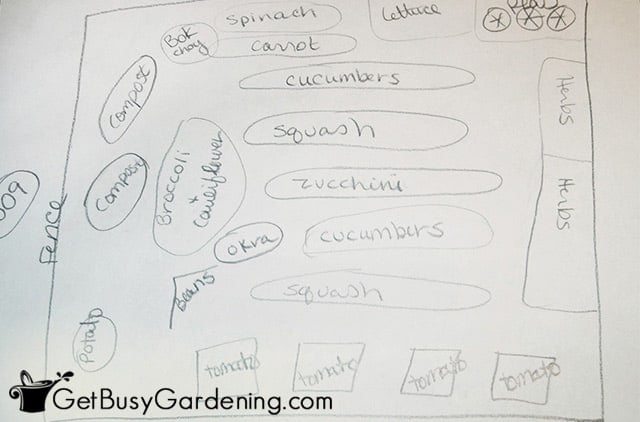
Creating Your Vegetable Garden Layout
Before I get into the detailed steps for how to design a vegetable garden, I wanted to talk about the benefits first. Then I will give you some tips for making it easy to create your drawing.
Benefits Of Having A Custom Sketch
I’ve already touched on a few of the benefits in my story above, but I wanted to list them here for you as well.
So, just in case you’re not quite convinced why you need to create a vegetable garden design, here are the benefits to help sway you…
- Easier to calculate how many plants you need – Without a vegetable garden design, it’s difficult to figure out how many seeds or plants you will need. So, when you end up with tons of leftovers at planting time (like I used to have), you’ll be tempted to overcrowd your veggies.
- Prevents pest and disease issues – Over-planting will not only make your vegetable plot less productive, it’s also a recipe for disaster. When veggies don’t have enough space, it’s an invitation for bugs and diseases to take hold, and spread quickly to other plants.
- Relieves your stress – Designing your vegetable garden ahead of time not only takes the stress out of planting, but harvesting and maintenance too. When you give yourself plenty of space to work, you will easily be able to see and reach everything.

- Allows for good record keeping – Saving your sketches is a great way to keep track of your vegetable patch, and how well everything did. Plus, it’s fun to look back at your sketches from the past, and see how much it all changes over the years.
- Simplifies crop rotation – Keeping all those old garden layout drawings also makes it much easier to rotate your crops. That way, you’ll be able to quickly see where everything was growing in previous years, and work crop rotation right into your design layout.
- Results in a better looking, more productive garden – Creating a design layout will ensure you give everything plenty of room to grow, resulting in a much more beautiful and bountiful veggie garden.
Just remember, plotting your veggie garden should be fun! So pour yourself a cup of coffee (or a glass of wine, ehem), sit down, get comfortable, and let’s get to it.
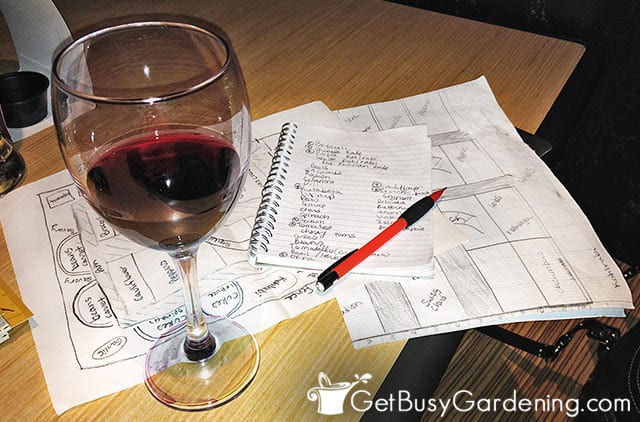
Tips For Drawing A Vegetable Garden Layout
Don’t worry, creating your own vegetable garden layout isn’t as hard as it sounds. You don’t need any fancy software, or a degree in home garden design.
You don’t even need any graph paper or any artistic ability (though it does help if you can read your own handwriting, haha!).
Check out these vegetable garden sketches my husband and I drew the other day while waiting for our food at a restaurant. Yep, those are cocktail napkins.
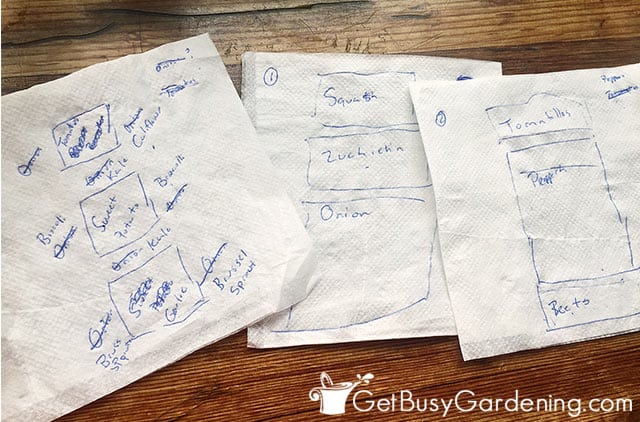
Of course, if you have a technical mind, you could pull out the graph paper, and get to work measuring, calculating, and drawing everything to scale.
I never used to do this, but I finally gave it a try after we added raised beds to our vegetable garden a few years ago.
That made using the graph paper super easy, since most of the beds are rectangular, and the same size. Now I have a design template that I can use every year.
Here’s my very first drawing using graph paper. (Please don’t be intimidated, it seriously took me years to get to this point!)
How To Design A Vegetable Garden Step-By-Step
Like I mentioned above, you don’t need anything special to create your drawing. Just a pencil and some paper. Oh, and you may want to grab a good eraser too.
Supplies Needed:
- Pencil
- Paper (or graph paper if you want to give that a try)
- Eraser
- Ruler (optional)
Step 1: Make a list of veggies – Before you start drawing your design, make a list of what vegetables you want to grow. That way you’ll have an idea of how much space you need for everything.
Step 2: Sketch out your veggie plot – Start by drawing the outline of your vegetable plot on a piece of paper (or a cocktail napkin, if you prefer).
Step 3: Add existing hardscaping – Next, add in any existing hardscapes (paths, raised beds, fences, arbors, etc). If you don’t have any existing hardscaping, then you can skip this step.
Step 4: Draw in the beds and paths – Sketch out a rough drawing of where you want to plant everything, and also where the walking paths will be.
I recommend making the paths between each bed or row at least 2′ wide. That will allow extra space for your veggies to sprawl without overgrowing the paths completely, and also give you plenty of room move around.
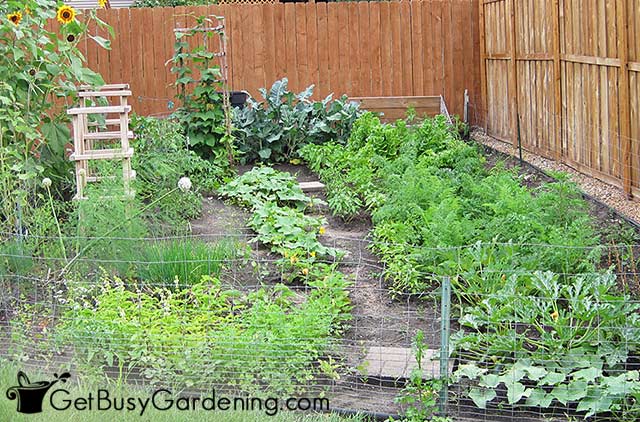
Step 5: Add the plants to your sketch – Think about where you want to grow each crop, and how to group them to make rotation easier.
You can simply note what you will plant in each area on an informal sketch. Or you can calculate the exact spacing you’ll need for each plant, and then add that to your scale drawing.
Step 6: Review your design – Visualize what your vegetable garden will look like when it’s full grown. Are you allowing enough space in your layout for everything you want to grow, and also for you to move around?
Remember, it’s much easier to make changes during the design phase than it will be at planting time. If it doesn’t fit in your layout sketch, then it’s probably not going to fit in your veggie patch either. So try to be impartial.
Step 7: Add some character – Planting everything in rows with walking paths in between can be boring, and takes up more space. So spice things, and add tons of character to take your vegetable garden to the next level!
Growing vertically not only saves space, allowing you to plant more veggies, it also adds interest. So be sure to include some trellises, arbors, or arches for vining crops into your design layout.
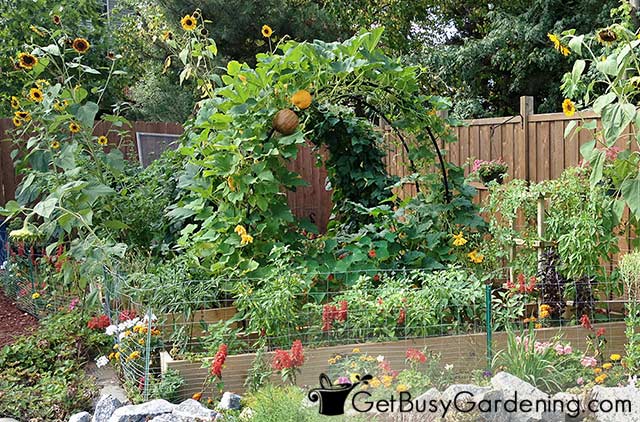
Drawing your vegetable garden layout is easy and fun! Once you get into the habit of doing it (and maybe even creating your own custom template) it will get easier every year. Just be sure to keep your sketches so that you can use them to create your designs year after year.
If you’d like to learn how to make the most of your space and get as much homegrown food as possible, then my Vertical Vegetables book is perfect! It will teach you all you need to know, has tons of gorgeous photos, and includes 23 DIY projects you can build for your own garden. Order your copy today!
Learn more about my Vertical Vegetables book here.
More About Vegetable Gardening
- A Beginner’s Guide To Companion Planting
- Beginner’s Guide to Mulching A Vegetable Garden
- How To Prepare A Garden Bed For Planting Vegetables
Share your tips for drawing a backyard vegetable garden design layout in the comments below.
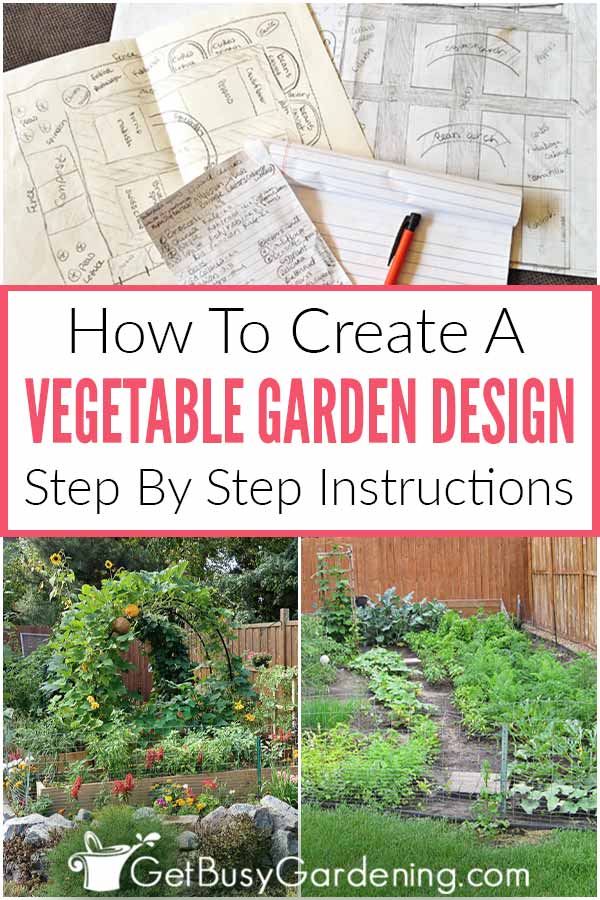
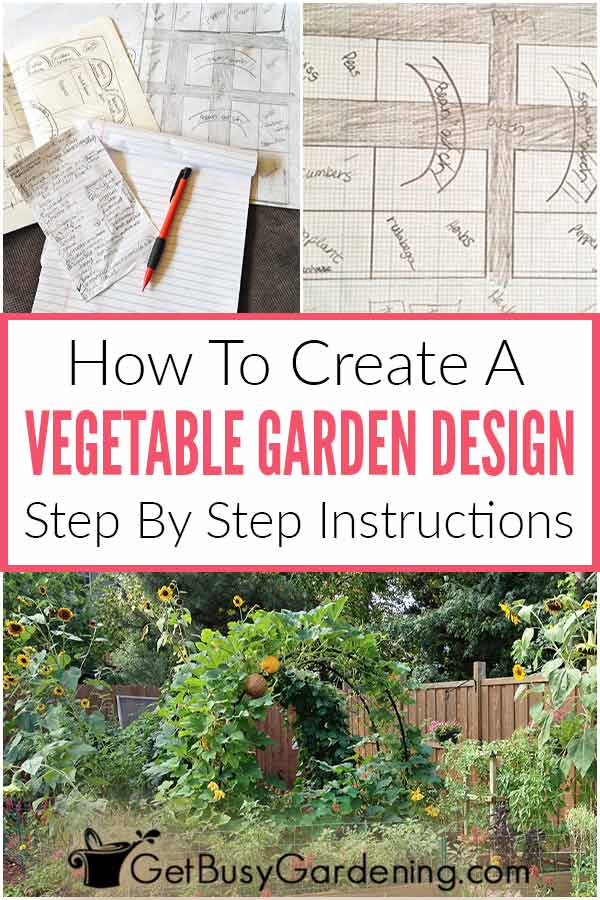
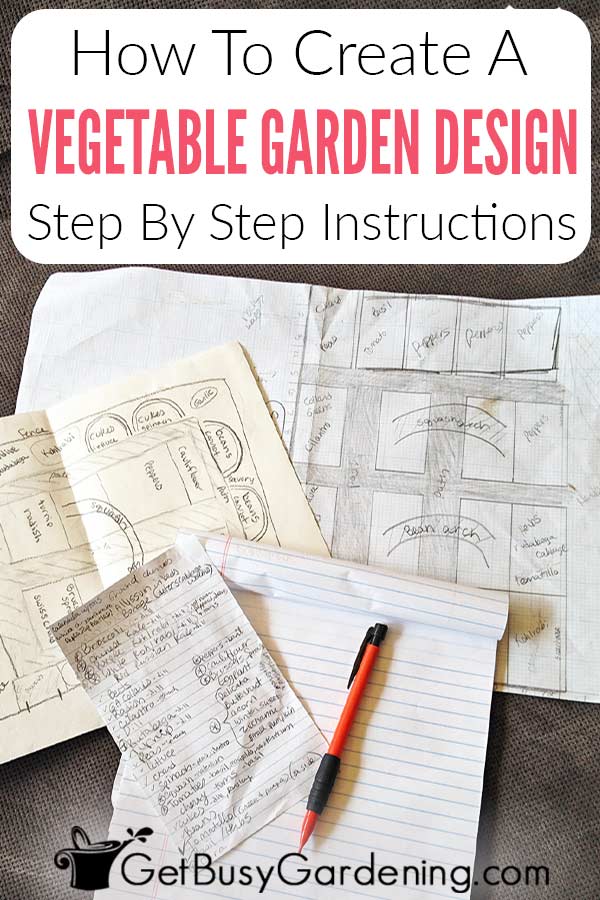

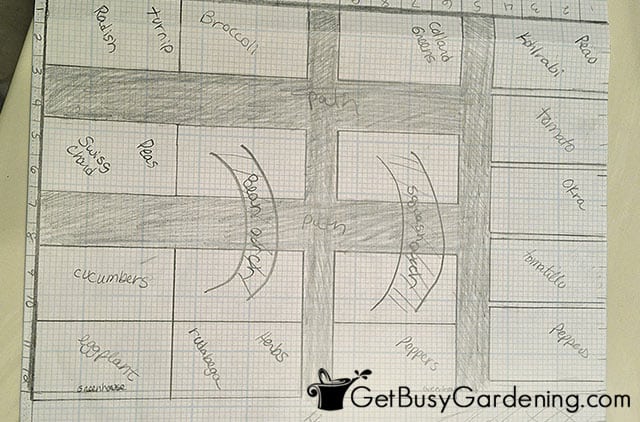


Arlene Dantry says
I love the arch trellis and would like to know if you made it and if so, how?
Amy Andrychowicz says
Thanks! Yes, I made it. I call it my squash arch. 🙂 Here’s more info… How To Build A Squash Arch
Ruth Quinlan says
Such a lovely design! The bean and squash arches are a very good idea. I wouldn’t think of that by myself and I’m surely including at least one arch in my garden plan this year. Got some more good ideas from your post. Thank you for sharing!
Amy Andrychowicz says
Thank you! Glad to hear you got some good ideas for designing your veggie garden layout, have fun with it!
Darlene says
in making your veggie layout design not only rotate your crops u should plan on companion planting when doing so
Amy Andrychowicz says
Absolutely! Thanks for adding that excellent tip.
Danny Young says
Add another step to the above list…(for next season)
…When the garden is up & growing take some photos with the date stamp turned on. Print them off & file them with your garden design plan. You can also list the plants & variety on the back of the photo.
Next winter when you start the new vegetable garden design you can refer to your previous sketches, notes & photos. This will make laying out the new design easier.
Amy Andrychowicz says
Yes, taking photos of your vegetable garden is a wonderful way to help come up with your new design every year. Thanks for sharing that tip, it’s a great one!
Angie says
I LOVE designing my veggie garden – it’s the only gardening thing I can do in the dead of winter before I’m able to plant my seedlings. I look at what I did the previous year – to make sure rotations work well, or best that they can. I look at what did well, what didn’t, what we had too much of, what we wished we had more of. Then, I plop down with the seed catalogs and decide everything I’m going to grow. I work it over for days trying to squeeze in everything I want to try until I have a good design layout figured out.
Reality sets in after the last frost, and sometimes these designs get changed. But for the most part, they stay pretty solid. I always have new things that I want to try – varieties AND gardening techniques. So I always make sure to have lots of room for those.
Amy Andrychowicz says
Sounds like you have a great system for figuring out your veggie garden layout every year! Thanks for sharing how you do it. Being able to easily adapt and change your design on the fly is part of what makes drawing it out ahead of time so important. Love it! 🙂
Angie says
I start drawing my layout before the snow is melted – it gets rid of that gardening itch early on in the season, and allows me to figure out how many veggie seedlings I need to start.
Amy Andrychowicz says
Yes, it’s good to plan your veggie garden layout ahead of time so that you know how many seedlings you’ll need. Great tip!
Victoria says
I agree on the importance of The Design but what stumps me isn’t doing what you’ve described in this post, but how to add that tricky fourth dimension, time. Where I live in Argentina is the equivalent to Zone 9b, so year-round veggie production, and the heat means summer is often NOT the most productive time. So my design process needs to take into account a constant rolling planting that covers the entire year. I have fixed beds, so I was thinking of printing out 12 blank designs, one for each month, to see if that helps me visualize things moving forward… Apparently one day it’ll all be intuitive, but till then…
Amy Andrychowicz says
Awesome! Sounds like you have a great system down for your year-round veggie garden design plan!
ItalianBelly says
Hi Amy,
My husband has plans to start a vegetable garden in our backyard once our house is done and I don’t really want anything to do with it because I know it requires hard work. He’s a winemaker and tends to his vines so I know he is capable. However, I doubt he is going to draw out a vegetable garden plan like your beautiful 2013 one. Before things may get out of control, I will make sure this plan gets done because I KNOW i will be doing the harvesting. So, thanks for the idea.
I also noticed your glass of red while you were doing your plans. I like how you work!
Amy Andrychowicz says
LOL, hopefully you can make sure he starts with a small veggie plot so it’s not too overwhelming! You’ll be glad you have it once you start getting the yummy fresh produce though. Good luck designing your garden layout, just keep it simple for your first try. And yes, wine is definitely a must when I’m planning my vegetable garden! 😉
Marie says
You are definitely ahead of me this year. I haven’t even decided whether or not to go for a veggie garden again this year. Time always gets away from me. Thanks for sharing your design tips with us!
Amy Andrychowicz says
Yah, I know what you mean. Maybe try designing a smaller vegetable garden this year, or just a few beds. Then you won’t feel so overwhelmed when time gets away from you. 🙂
Joan Conklin says
Can you be specific on what kind of squash works best on the arch? This is my third year gardening. My biggest problem is rodents…..any solutions. I have circles inside of circles as my vegetable garden layout….over 14 ft. Like a huge clock.
I am now building pathways since it was difficult to deal with planing the design. In the middle. I use 4 bamboo sticks to create tepees for my beans and peas. Need information on crop rotation.
I have seedlings planted in my kitchen and small plastic outside greenhouse. I really want to know about shade….most of my garden gets sun….but I have a shady area. And do I grow all my herbs together?
Live in Vancouver, Canada….HELP PLEASE. I really am winging it!
Amy Andrychowicz says
Here’s a post I wrote with more details about the arch, including a list of varieties that would work well… How To Build a Squash Arch
I haven’t had any issues with rodents eating my squash vines, and growing it vertically will get the fruits off the ground so you won’t have to worry about the rodents getting to them.
My vegetable garden is also in part shade, and here’s a list of vegetables that I’ve had success with in that area… Growing Vegetables In Part Shade
getfitchick says
The 2013 garden is absolutely fantastic! Growing up, we always planted a garden but it was always a square plot. This year my mother and I are doing a smaller garden and I’m using your design tips as inspiration – thank you!
Amy Andrychowicz says
Thank you! Awesome, and you are welcome! 🙂
Martie says
I usually leave most of the gardening to my hubs, but I think I’ll show this to him this year! Maybe we can make an epic garden design like yours! 🙂 Thanks for sharing!
Amy Andrychowicz says
Yes, that would be great! You totally can do this. 🙂
Charlene says
Love that squash arch in your 2013 vegetable garden — it would be so practical in keeping the squash off the ground and it adds a whole new dimension to the look of the space. Great idea!
Amy Andrychowicz says
Thanks! 🙂 Here’s a link to the design plans if you want to make your own… How To Build A Squash Arch For Your Garden
Tori Cole says
Thank you for getting me motivated! I need to get busy plotting out my vegetable garden!
Amy Andrychowicz says
You’re welcome! Have fun. 🙂
gigi says
I love the arch! I don’t know if we could pull that off, tho! I will be on our second garden this year. Last year, we used a website where you can do your design plan on line. You drag the vegetables you want into your row and it tells you how far to plant them, etc. I’m not going to do that this year. It was okay, but I think drawing a sketch will be better for us. This year, I know the things I want in our garden. I’m so looking forward to it!
Amy Andrychowicz says
Thanks! That website sounds really cool, but maybe overcomplicated? Have fun drawing out your veggie garden design! It’s one of my favorite things to do. 🙂
Mandy says
HI Amy,
This will be my second year using my raised bed veggie garden. It has made gardening more productive and less strain on my back. I also read up on companion gardening. Is that the same as when you mentioned, about grouping plants to make crop rotation easier?
Also, what do you grow beneath the squash arbor?
I really enjoy your blog.
Thanks.
Amy Andrychowicz says
Hi Mandy,
I love my raised beds too (plus they make designing my layout ever year super easy!). No, groping plants in the same family is not the same thing as companion planting. I group plants in the same family to make crop rotation easier. Companion planting has to do with growing plants together that will help the plants grow in some way (or keeping plants apart that won’t grow well together). Here is a post I wrote so you can read more about it… A Beginner’s Guide To Companion Planting.
Carole Coates says
Great article and how your garden has progressed in four years! We make a plan, then have to keep revising it because we keep adding more veggies. (No self control here!) As our knees get crankier and our backs get stiffer, we’ve had to make some adjustments to our veggie garden layout: wider paths are easier to negotiate, raised beds need to be raised a little higher, and because our garden is on a rocky mountainside, we’re adding steps to the slippery slopes we keep sliding down and we’ve gotten really serious about finding and removing all those hidden rocks that can so easily trip us up. A sprained ankle or knee replacement would be so very inconvenient!
Amy Andrychowicz says
Wow, I would love to see your design, or pictures of your vegetable garden. It sounds amazing!! It also sounds like you have a busy gardening season ahead of you. Good luck with all of your projects!